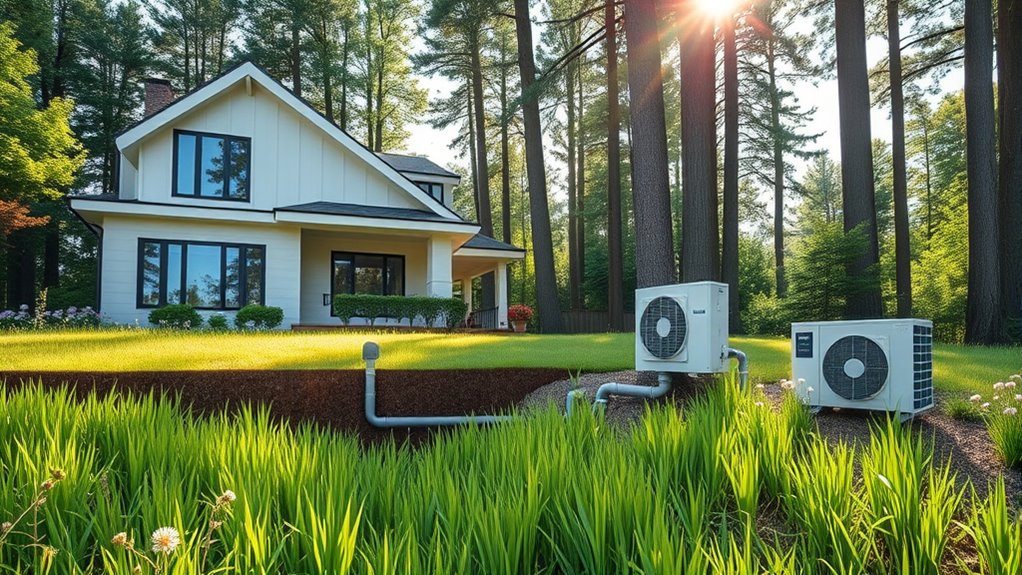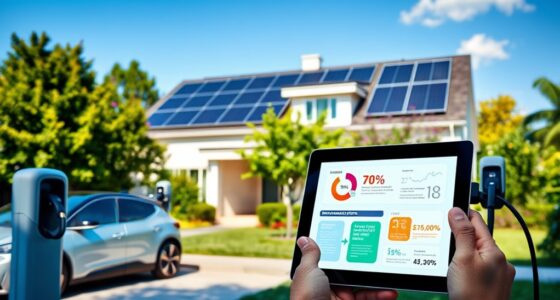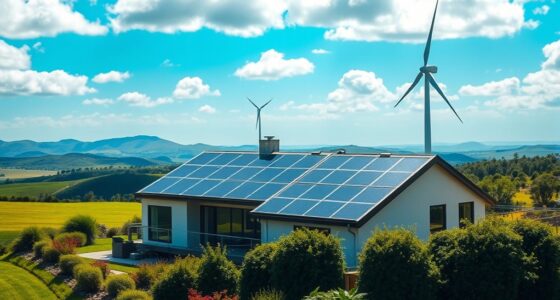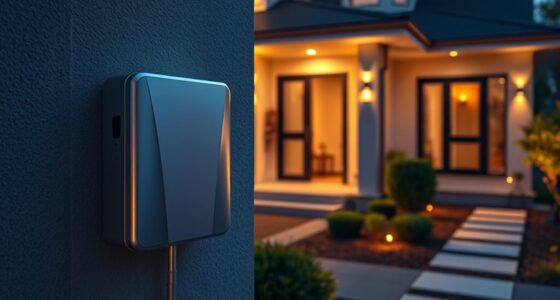Geothermal heating and cooling systems use the stable ground temperature beneath your property to control indoor climate efficiently year-round. Pipes called ground loops are buried underground to absorb or release heat depending on the season, while a heat pump transfers this heat into or out of your home. This system reduces energy use, lowers utility bills, and offers long-lasting, eco-friendly comfort. If you want to understand how it all works and benefits your home, keep exploring the details.
Key Takeaways
- Geothermal systems use underground pipes called ground loops to exchange heat for indoor climate control.
- They operate year-round by absorbing heat in winter and dissipating heat in summer, ensuring efficient heating and cooling.
- Components include buried ground loops, an indoor heat pump, ductwork, and thermostats, compatible with existing HVAC systems.
- These systems are energy-efficient, environmentally friendly, and require minimal maintenance due to durable underground components.
- Initial installation costs are higher, but they offer long-term savings, reliable performance, and reduce reliance on fossil fuels.
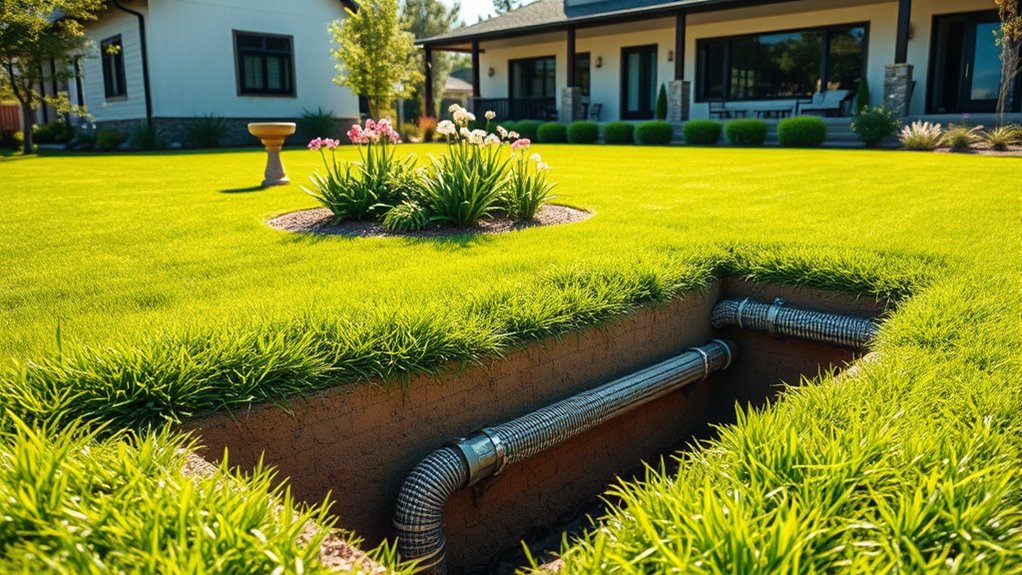
If you’re looking for an energy-efficient way to heat and cool your home, geothermal systems offer a sustainable solution. These systems leverage the stable temperature of the ground, which remains around 40°-70°F year-round, to provide efficient climate control. Instead of relying on traditional heating and cooling methods, geothermal setups circulate a fluid—water or antifreeze—through underground pipes called ground loops. These pipes are buried several feet underground on your property. During winter, the system absorbs heat from the ground and transfers it to your home, warming the indoor air. Conversely, in summer, it pulls heat from your house and deposits it into the ground, effectively cooling your living space.
Geothermal systems use underground pipes to efficiently heat and cool your home year-round.
Inside your home, a heat pump works as the core component of the system. It takes the heat energy from the ground loop and converts it into warm air for winter heating. In summer, it reverses the process, extracting heat from indoor air and releasing it into the ground. This process ensures your home remains comfortable regardless of outdoor weather conditions. The system can also provide hot water with little additional energy, making it a versatile option for your household needs. The entire setup includes a ground loop piping system buried underground, a heat pump inside your house, and standard thermostats and ductwork compatible with existing HVAC setups—making retrofits feasible.
Additionally, geothermal systems depend on ground heat that remains relatively constant, which enhances their efficiency and reliability throughout the year. One of the main advantages of geothermal systems is their high energy efficiency. Because they utilize the earth’s consistent temperature, they consume less electricity than conventional HVAC systems, reducing your utility bills over time. They also cut reliance on fossil fuels, leading to lower carbon emissions and a smaller environmental footprint. Since these systems operate quietly with no combustion involved, they produce no onsite emissions and contribute to cleaner indoor air quality. Their durability results in a long service life and low maintenance costs, further enhancing their cost-effectiveness.
Installing a geothermal system requires enough land to bury the ground loops, and the initial setup can be more expensive than traditional HVAC systems. However, professional assessment is essential to determine the best system size and placement based on your soil type, climate, and property size. Once installed, the system offers stable, year-round performance, maintaining indoor comfort while operating quietly and reliably in all seasons. It also supplies hot water efficiently, adding to its convenience. Ultimately, geothermal heating and cooling harness renewable energy stored beneath the surface, helping you save money and reduce environmental impact while enjoying consistent, comfortable indoor temperatures.
Frequently Asked Questions
What Is the Typical Lifespan of a Geothermal Heating System?
You’re wondering about the typical lifespan of a geothermal heating system. Generally, the ground loops can last over 50 years, sometimes even beyond 100 with proper care. The heat pump itself usually lasts 20 to 25 years, and with regular maintenance, you can maximize its life. Overall, a well-maintained geothermal system often outlasts traditional HVAC systems, providing reliable heating and cooling for decades.
Are There Any Government Incentives for Installing Geothermal Systems?
You’re asking about government incentives for installing geothermal systems. The federal government offers a 30% Residential Clean Energy Tax Credit through 2032, which helps cut installation costs. Additionally, the Inflation Reduction Act boosts this credit and encourages wider adoption. Some states and utilities may also provide rebates or incentives. These programs make geothermal systems more affordable, reduce your energy bills, and support your efforts to lower your carbon footprint.
How Much Space Is Needed for a Geothermal System Installation?
The space needed for a geothermal system can seem as vast as a football field, but it really depends on your system type. Horizontal loops require about 400 to 8,000 square feet, while vertical systems need less surface area but involve deep drilling. Factors like property size, soil, and obstacles influence space requirements. Proper planning guarantees your system operates efficiently without taking over your entire yard.
Can Geothermal Heating Be Combined With Existing HVAC Systems?
Yes, you can combine geothermal heating with existing HVAC systems. This integration often uses your current ductwork, making installation smoother. It boosts energy efficiency and provides consistent comfort year-round. Just confirm your existing system is compatible, and you might need professional help to review your setup. Combining these systems can lower energy bills, reduce environmental impact, and increase your home’s value, making it a smart upgrade.
What Maintenance Is Required for Geothermal Heating and Cooling Systems?
Imagine you’re tending to a vintage car; geothermal systems need similar care. You should check coolant levels regularly, inspect ground loops for leaks, and replace air filters. Confirm electrical connections are secure, and verify thermostat calibration. Regularly inspect heat exchangers, lubricate motors, and examine piping. Proper maintenance prolongs system life, keeps it running efficiently, saves money, and helps protect the environment, all while providing consistent comfort.
Conclusion
Now that you understand how geothermal systems work, it’s interesting to realize how often nature’s own energy aligns with our efforts to stay comfortable. As you consider upgrading your home, remember that this sustainable choice not only saves money but also taps into Earth’s quiet, reliable warmth—coinciding beautifully with your desire for efficiency and eco-friendliness. Embracing geothermal heating and cooling might just be the natural coincidence your home needs for a smarter, greener future.

